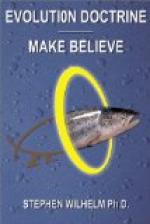According to the account now generally accepted, the original material of the earth seems to have been a semi-solid or semi-fluid mass formed by the condensation of the still more fluid or even gaseous nebula out of which all the planets of the solar system have been formed and of which the sun is the still fiery core. As soon as the earth had cooled sufficiently its substances crystallized and wrinkled to form the first mountains and ridges; between and among these were the basins which soon filled with the condensing waters to become the earliest lakes and oceans. The wear and tear of rains and snows and winds so worked upon the surfaces of the higher regions that sediments of a finer or coarser character like sand and mud and gravel were washed down into the lower levels. These sediments were afterwards converted into the first rocks of the so-called stratified or sedimentary series, as contrasted with the crystalline or plutonic rocks like the original mass of the earth and the kinds forced to the surface by volcanic eruptions. Later the earth wrinkled again in various ways and places so that new ridges and mountains were formed with new systems of lakes and oceans and rivers; and again the elements continued to erode and partially destroy the higher masses and to lay down new and later series of sedimentary rocks upon the old.
It seems scarcely credible that the apparently weak forces of nature like those we have mentioned are sufficiently powerful to work over the massive crust of the earth as geology says they have. Our attention is caught, as a rule, only by the greater things, like the earthquakes at San Francisco and Valparaiso, and the tidal waves and cyclones of the South Seas; but the results of these sporadic and local cataclysms are far less than the effects of the persistent everyday forces of erosion, each one of which seems so small and futile. When we look at the Rocky Mountains with their high and rugged peaks, it seems almost impossible that rain and frost and snow could ever break them up and wear them down so that they would become like the rounded hills of the Appalachian Mountain chain, yet this is what will happen unless nature’s ways suddenly change to something which they are not now. A visitor to the Grand Canon of the Colorado sees a magnificent chasm over a mile in depth and two hundred miles long which has actually been carved through layer after layer of solid rock by the rushing torrents of the river. Perhaps it is easier to estimate the geological effects of a river in such a case as Niagara. Here we find a deep gorge below the famous falls, which runs for twenty miles or so to open out into Lake Ontario. The water passing over the brim of the falls wears away the edge at a rate which varies somewhat according to the harder or softer consistency of the rocks, but which, since 1843, has averaged about 104 inches a year. Knowing this rate, the length of the gorge, and the character of the rocky walls already carved out, the




